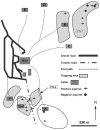Cluster of sylvatic epidemic typhus cases associated with flying squirrels, 2004-2006
- PMID: 19624912
- PMCID: PMC2744229
- DOI: 10.3201/eid1507.081305
Cluster of sylvatic epidemic typhus cases associated with flying squirrels, 2004-2006
Abstract
In February 2006, a diagnosis of sylvatic epidemic typhus in a counselor at a wilderness camp in Pennsylvania prompted a retrospective investigation. From January 2004 through January 2006, 3 more cases were identified. All had been counselors at the camp and had experienced febrile illness with myalgia, chills, and sweats; 2 had been hospitalized. All patients had slept in the same cabin and reported having seen and heard flying squirrels inside the wall adjacent to their bed. Serum from each patient had evidence of infection with Rickettsia prowazekii. Analysis of blood and tissue from 14 southern flying squirrels trapped in the woodlands around the cabin indicated that 71% were infected with R. prowazekii. Education and control measures to exclude flying squirrels from housing are essential to reduce the likelihood of sylvatic epidemic typhus.
Figures
References
-
- Sonenshine DE, Bozeman FM, Williams MS, Masiello SA, Chadwick DP, Stocks NI, et al. Epizootiology of epidemic typhus (Rickettsia prowazekii) in flying squirrels. Am J Trop Med Hyg. 1978;27:339–49. - PubMed
Publication types
MeSH terms
LinkOut - more resources
Full Text Sources

